Jaguar (Panthera onca)
The jaguar (Panthera onca) is a large cat native to the Americas. It is the third-largest feline species after the tiger and the lion, and the largest in the Americas. The jaguar is an apex predator and is known for its power and strength. It is a solitary and secretive animal, and is mostly active at dawn and dusk. The jaguar has a distinctive coat with large, black spots arranged in a circular pattern. Jaguar is also the largest and most formidable cat in the western hemisphere, and it has the strongest jaws among cats. It has a strong, muscular body and a powerful bite, which it uses to kill its prey by biting through the skull or spinal cord. Jaguars are found in a variety of habitats, including rainforests, swamps, and grasslands, but they are most commonly found in dense forests. They are skilled swimmers and climbers, and are known to take down prey much larger than themselves, such as deer, wild pigs, and even caiman.
The jaguar is a majestic and powerful big cat that roams the lush jungles and dense forests of the Americas. With its muscular body and stunning coat pattern, the jaguar is a true icon of the animal kingdom, revered and admired by people all over the world.
But beyond its impressive physical appearance, the jaguar is a fascinating creature with a rich cultural and ecological significance. For centuries, the jaguar has been revered by indigenous peoples across the Americas, who have long recognized its spiritual power and revered it as a symbol of strength and courage.
Despite its cultural significance, however, the jaguar faces a number of threats to its survival in the wild. Habitat loss, poaching, and human-wildlife conflict all pose significant challenges to the long-term survival of this iconic species. As such, conservation efforts are more critical now than ever before.
Fortunately, there is hope on the horizon for the jaguar. In recent years, conservation organizations and government agencies across the Americas have stepped up efforts to protect the species and its habitat, implementing a range of measures aimed at ensuring the long-term survival of the jaguar in the wild.
In this article, we’ll take a deep dive into the world of the jaguar, exploring its biology, behavior, cultural significance, and conservation status. Through the stories of the people and organizations working to protect this iconic species, we’ll gain a deeper appreciation for the incredible beauty and complexity of the natural world and the critical importance of safeguarding it for future generations. So join us as we embark on a journey into the wild and wonderful world of the jaguar, and discover the magic and majesty of this extraordinary big cat.
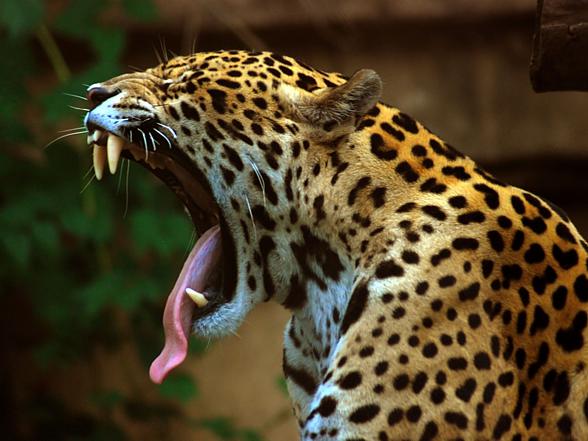
Classification
- Class: Mammalia
- Order: Carnivora
- Family: Felidae
- Genus: Panthera
- Species: Jaguar (Panthera onca)
Color variation
Jaguars are generally known for their distinctive coat, which is typically yellow or gold in color and covered with black spots arranged in a circular pattern. These spots, called rosettes, are most densely concentrated on the head, neck, and legs, and are larger and more open than those of leopards. However, jaguars can also come in a variety of other colors, including white, black, and even blue-gray. These color variations are due to a genetic mutation called melanism, which causes an excess of the pigment melanin to be produced in the skin and fur. Jaguars with melanism are often referred to as “black panthers” although the term “panther” can also refer to leopards and cougars with melanism.
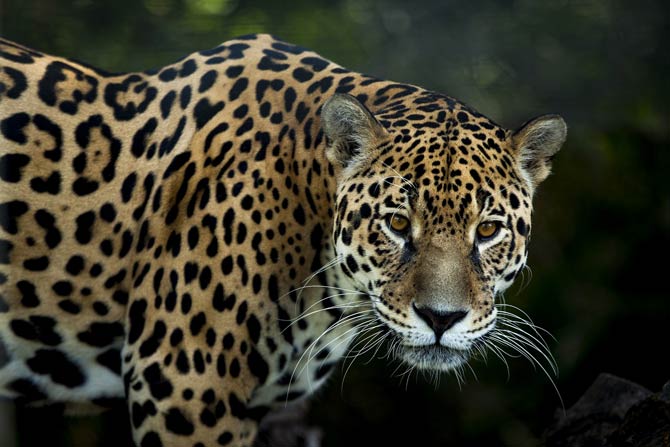
Distribution and habitat
Jaguars are native to the Americas and can be found in a variety of habitats, including rainforests, swamps, grasslands, and scrublands. They are most commonly found in dense forests, where they can find plenty of shade and cover.
Jaguars are found across much of South and Central America, including countries such as Argentina, Belize, Bolivia, Brazil, Colombia, Costa Rica, Ecuador, French Guiana, Guatemala, Guyana, Honduras, Mexico, Nicaragua, Panama, Paraguay, Peru, Suriname, and Venezuela. They are also found in parts of the southwestern United States, including Arizona, New Mexico, and Texas.
The range of the jaguar has decreased significantly in recent centuries due to habitat loss and other human activities.
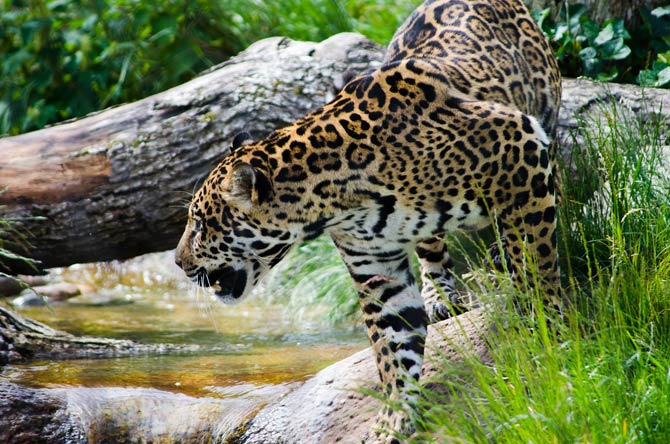
Jaguar and leopard – differences
The jaguar is a very muscled cat. Although it resembles the leopard in appearance, it is more robust – it has relatively short, chunky limbs and a well-built chest. The jaguar may be distinguished from the leopard by the look of rosettes – those of the jaguar have small central spots. The habitats, features and behaviors of the jaguar are very similar to those of the tiger. See Comparison of jaguar and leopard.
Fans of motorization may feel offended, but the leopard, in our opinion, is more graceful than the jaguar 🙂

Occurrence
The jaguar inhabits both grassy areas and tropical forests in South and Central America. It can be also found on deserts in the southern part of North America (Arizona). Extinct species could also be found in Asia, Europe and Africa, where the species evolved over 2 million years ago. The analysis of mitochondrial DNA showed, however, that the jaguar appeared on Earth 280-510 thousand years ago, which is later than archaeological finds suggested.
Hunting and diet
Jaguars are carnivorous animals and their diet consists mainly of large mammals such as deer, wild pigs, and capybaras. They are also known to eat smaller prey, including rodents, reptiles, and birds. Jaguars are skilled hunters and are known for their ability to take down prey much larger than themselves. They are skilled at stalking and ambushing their prey, and are able to kill with a single bite to the neck or head.
Jaguars are solitary animals and tend to hunt alone. They are mostly active at dawn and dusk, and will often rest during the heat of the day. They are skilled swimmers and climbers, and are known to take down prey in or near water. Jaguars will also hunt on land.
Jaguars are apex predators, which means that they are at the top of the food chain and have no natural predators. They play an important role in maintaining the balance of their ecosystem by controlling the populations of their prey species.
Great swimmer
Jaguars are great swimmers, so they choose habitats rich in water resources (swamps). They are fond of seasonally flooded forests and thickets at river banks.
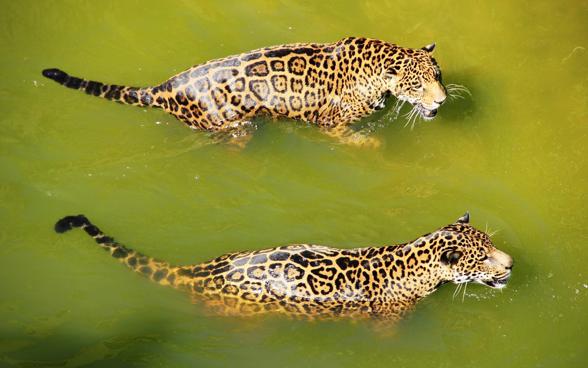
Forest is the jaguar’s element
Jaguars are rare in open areas. They feel great in semi-darkness of tropical forests. The characteristic pattern on the jaguar’s fur provides it with perfect camouflage among patches of light and shadows, which makes hunting easier.
Appearance
Jaguars usually have reddish and yellowish fur. Stomach, inner legs, front of the neck and chin are usually white.
The back and sides are partially covered with black round or linear markings, and partially with larger yellowish-red spots and rings with black edges (rosettes).
In all subspecies of the jaguar (since 2017, the jaguar is considered to be a monotypic taxon, so currently we do not distinguish subspecies), despite a variety of coloration, you can always see a black spot in the corner of the mouth and a dark marking with white or yellow center on the back of the ear.
Black panther
Although it’s rare, there are also darker or entirely black, melanistic types of jaguars, so called “black panthers”. Similar individuals may be also found among leopards. The black panther has black fur, both in the jaguar and leopard, because of the greater amount of pigment (melanin).
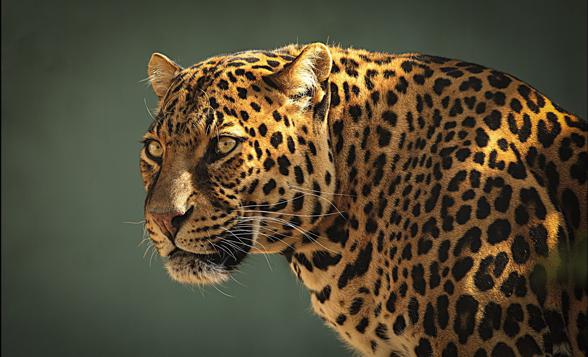
Jaguar’s hunting, diet, and prey
The jaguar hunts mostly on the ground (although it can climb trees), usually at night. It uses the bite force which it uses to sink its teeth into the neck of its prey as soon as possible after an attack.
The jaguar can run really fast for short distances, but it gets tired very easily, so chasing its prey isn’t its strongest skill.
Jaguars, as most of cats, have to attack their prey by surprise. They mostly hunt big mammals (tapirs, capybaras, peccaries). When the jaguar is hungry, it also eats smaller mammals and birds, tortoises, and caimans. It often feeds on fish. The jaguar can lie silent above water surface and quickly grab a fish with its forepaw, just as bears do. After having caught its prey, the jaguar moves it in a safer place. Food waste is buried. A hungry and threatened jaguar can attack a human.
Jaguars were cult objects for indigenous people of America, including the ancient Maya people and the Aztec.
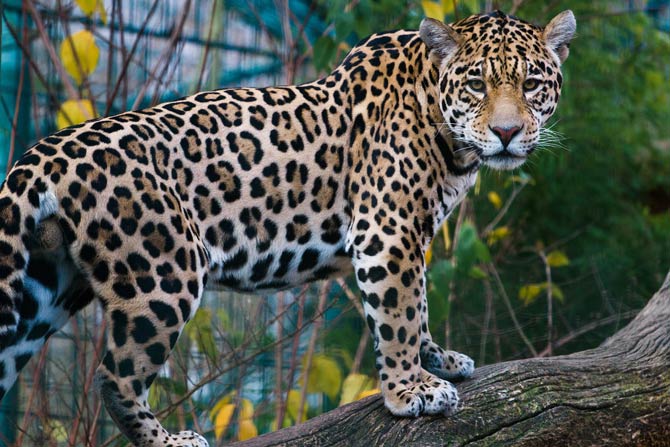
Attacks on humans
Jaguars are generally not known to attack humans, and incidents of jaguars attacking people are rare. Jaguars are typically elusive and solitary animals, and will generally avoid human contact if possible. However, jaguars are apex predators and are capable of causing serious injury or death to humans if they feel threatened or provoked. It is important to remember that jaguars are wild animals and should be respected as such.
There are a few factors that can increase the risk of a jaguar attack on a human. For example, if a jaguar is injured or sick, it may be more likely to attack humans as it is less able to defend itself or hunt its usual prey. In addition, if a jaguar is habituated to humans, it may be more likely to attack if it becomes accustomed to receiving food or other rewards from people.
If you are in an area where jaguars are found, it is important to follow proper safety guidelines to reduce the risk of an attack. This may include staying on designated trails, avoiding solitary activities in areas where jaguars are known to be present, and carrying bear spray or another deterrent to use in the event of an encounter. If you do encounter a jaguar, it is important to remain calm and avoid making direct eye contact or running, as these actions may be perceived as aggressive. Instead, try to back away slowly and give the jaguar plenty of space. If you are attacked by a jaguar, fight back with whatever means you have available, such as using your fists, a stick, or a weapon.
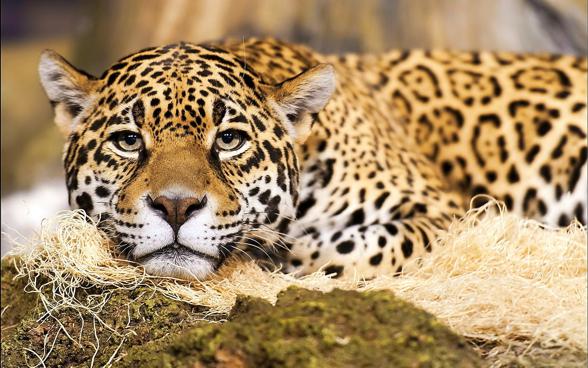
Conservation and Threats
Jaguars are listed as Near Threatened on the International Union for Conservation of Nature’s (IUCN) Red List of Threatened Species, due to habitat loss and poaching. Jaguars have a wide range, but their populations are declining in many areas due to a variety of threats.
One of the main threats to jaguars is habitat loss and degradation. As human populations have grown and urban areas have expanded, natural habitats have been destroyed or fragmented, making it difficult for jaguars and other wildlife to survive. In addition, many natural habitats are being converted for agriculture, mining, and other human activities, which can destroy the ecosystems that jaguars depend on.
Poaching is another major threat to jaguars. Despite being protected by law in many countries, jaguars are often hunted illegally for their skins, which are highly prized in the illegal wildlife trade. In addition, jaguars are sometimes killed by farmers or ranchers who view them as a threat to their livestock.
Climate change is also a potential threat to jaguars, as it can alter the habitats and ecosystems that they depend on. In addition, jaguars may be affected by diseases that are transmitted by other animals, such as domestic livestock.
There are several conservation efforts underway to protect jaguars and their habitats. These efforts include establishing protected areas, such as national parks and reserves, where jaguars can live and breed without interference from humans. In addition, conservation organizations are working to educate people about the importance of jaguars and the need to protect them, and are also working to reduce the demand for illegal wildlife products. Finally, research is being conducted to better understand jaguars and their habitats, in order to inform conservation efforts and help protect these animals for future generations.
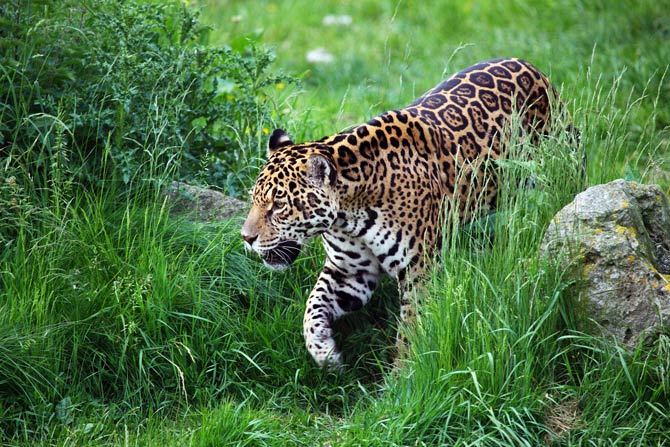
In culture and mythology
Jaguars have a long history of cultural significance in the Americas, and have played a central role in the mythology and folklore of many indigenous communities.
In many indigenous cultures, the jaguar is revered as a powerful and sacred animal, and is often associated with strength, courage, and nobility. Jaguars are often depicted in art and literature as symbols of power and are revered as important spiritual beings. In some cultures, the jaguar is believed to be a messenger from the spirit world, and is seen as a guardian and protector.
In some cultures, the jaguar is also associated with the sun and is seen as a symbol of life and warmth. In other cultures, the jaguar is associated with the moon and is seen as a symbol of mystery and the unknown.
In addition to their cultural significance, jaguars have also played a role in the mythology and folklore of many indigenous communities. In some stories, the jaguar is depicted as a powerful and feared predator, while in others, it is seen as a wise and noble animal. Jaguars are often featured in traditional stories and legends, and are often seen as important spiritual guides or helpers.
Overall, the jaguar has had a significant cultural and spiritual impact on many indigenous communities in the Americas, and continues to be revered as a powerful and respected animal.
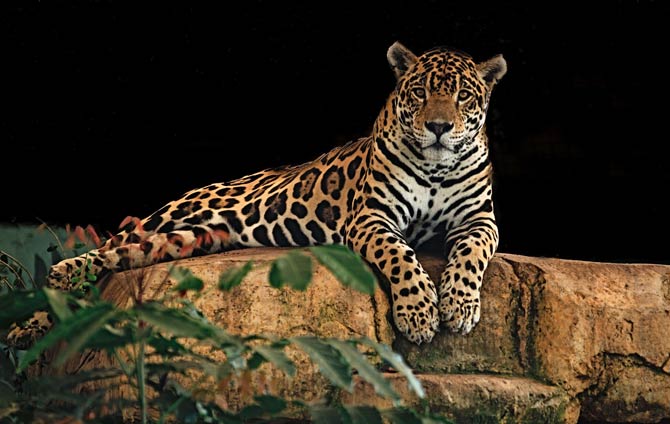
Detailed characteristic / size
Jaguar (Panthera onca)
- Body length without the tail: 120-185 cm (3ft 11in – 6ft)
- Tail length: 45-75 cm (18 to 30 in)
- Height at shoulders: 63-76 cm (25 to 30 in)
- Weight: 56-96 kg (123 – 211 lb), 160 kg (352 lb) maximum
- Gestation period: 91-111 days
- Sexual maturity: females: 1-2 years, males 2-3 years
- Number of cubs in a litter: 1-4 (usually 2-3)
- Lifespan: 11-12 years in the wild, up to 28 years in captivity
- Females are 10–20% smaller than males
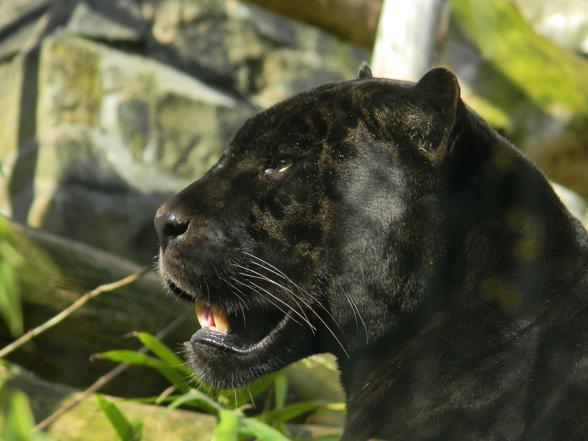
Jaguar – interesting facts
- Jaguars have the strongest jaws among all felids and are able to bite through the shells of armored reptiles such as turtles and crocodilians.
- Jaguars are excellent swimmers, and are known to swim across rivers and streams to hunt and travel. They are also skilled climbers and are able to climb trees in search of prey or to escape from danger.
- Jaguars have a distinctive vocalization that sounds like a mix between a growl and a purr. They also communicate through body language and scent marking, using their urine and feces to mark their territories and attract mates.
- Jaguars have a unique immune system that allows them to consume a wide variety of prey, including animals that are toxic or diseased. This is thought to be an adaptation that helps them survive in their diverse habitats.
- Jaguars are known to be intelligent animals, and have been observed using tools and exhibiting complex problem-solving behaviors.
- Jaguars have a distinctive, powerful roar that can be heard up to 3 miles (5 kilometers) away. They use their roar to communicate with other jaguars and to defend their territories.
- Jaguars are solitary for most of a year, similarly to tigers.
- In the mating season (August and September), males fight with each other.
- Young jaguars weigh 0.7-0.9 kg (1 lb 9 oz – 1 lb 16 oz) after birth.
- Jaguars include also individuals called “black panthers”.
- Jaguars are very difficult to tame. Although it’s relatively easy with their cubs, adult individuals may be threatening even for their caretakers.
- Jaguars can be bred with lions in captivity – a crossbred between a male jaguar and lioness is called a jaglion, and a crossbred between a lion and female jaguar is called a liguar.
- In zoos, jaguars often live twice or even thrice longer than in the wild.
- Jaguars breed every two years.
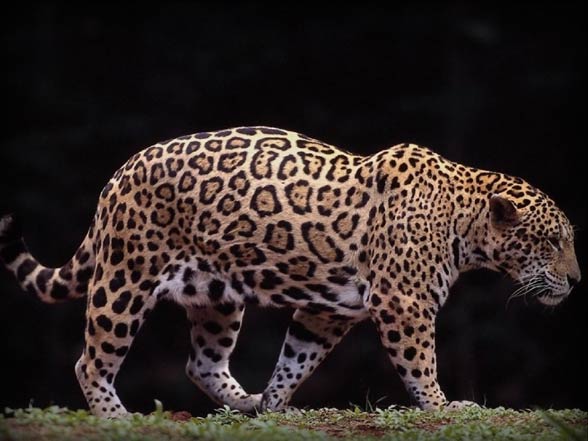




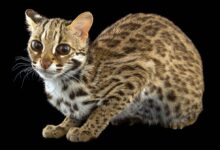


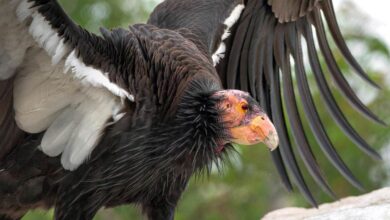



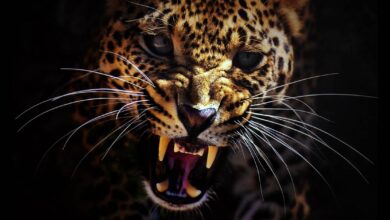




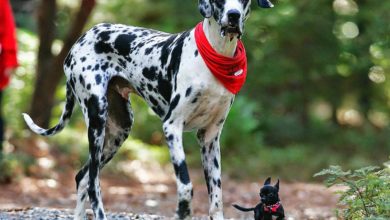
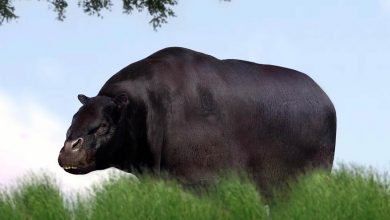

Actually, two of the pictures you have used here as jaguars are not jaguars, rather leopards…
1. In the picture you used to compare a Jaguar and a Leopar, two cats are leopards… the one on the left is a “Gabon Leopard”, which is a stocky subspecies somewhat resembling a jaguar… and the one on the left şs an African Savanna Leopard…
2. The picture you used under the title of “Appearance” is also a leopard, not a jaguar…
If you compare the face with the other jaguar pictures, you will easily be able to see the difference…
Thank you James, we have to verify these pictures.
Do jaguars also hunt the big anacondas? Like 5meter+? I am talking about the bigger side of jagurs like those 100kg+ males
I have not come across any reports or evidence of jaguars hunting such large snakes.
Why would a jaguar hunt such a large snake and risk it? Hunting smaller prey carries less risk of injury or wounds and you get eaten practically the same. Would you, being a predator, take unnecessary risks?